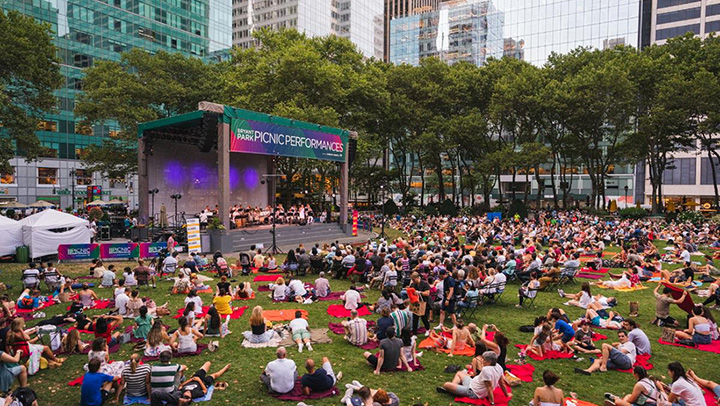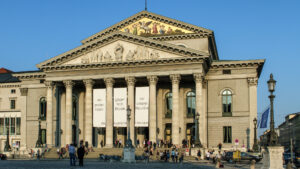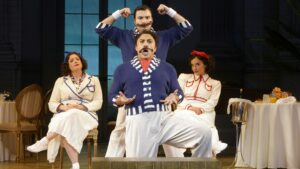And the answer is basically yes, when some other arts presenter can back them with funding and a venue. Michael Capasso, general director of the company NYCO Renaissance, an organization that obtained the rights to the name and assets of New York City Opera, was a known quantity in the New York opera world. In fact, a little too well known from his days as founder of the DiCapo Opera. He was known for fighting with colleagues and, unfortunately, not paying his artists. When Capasso launched the revival of City Opera with wealthy hedge fund manager Roy Niederhoffer, there seemed to be an infrastructure in place to keep things running smoothly.
Sadly, at a certain point Niederhoffer exited the scene along with a lot of capital, and then the company’s wanderings began. Basically, what we have is an opera company without a venue, without a resident orchestra and chorus, and without an endowment or funding. Performances are sponsored by other organizations for which Capasso will act as a concert planner putting together a show for another producing entity. For several seasons, opera concerts have been performed in collaboration with Bryant Park Picnic Performances which is funded by the City of New York and Bank of America.
The New York City Opera Renaissance opened its operations in 2016 with performances of Giacomo Puccini’s Tosca at the Rose Theater at Jazz at Lincoln Center. The same opera opened the first New York City Opera season in 1943 with Dusolina Giannini as the Roman diva. This past Saturday night August 24th, City Opera presented the same opera in concert as part of the Bryant Park Picnic Performances in honor of the 100th Anniversary of Puccini’s death. It was free to the public and according to estimates, over 6000 people attended. Two of the performers on Saturday night, Kristin Sampson as Tosca and Michael Chioldi as Baron Scarpia, appeared in the two casts that performed the opera at the Rose Theater back in 2016. The newcomer was the talented, young and attractive tenor Victor Starsky, a New York native from Richmond Hill, Queens as Mario Cavaradossi.
httpvh://youtu.be/ww4xH6ZvgO8
The opera was performed without an orchestra. Pianist Kathryn Olander labored mightily in place of Puccini’s cinematic orchestration and there were about 13 or 14 choristers to give us some partial idea of the Act I Te Deum finale. The scene with the Sacristan and child choristers was omitted along with a few other bits and pieces including part of the Act III introduction. Conductor Joseph Rescigno acted as traffic cop making sure that musical entrances and exits were maintained, but otherwise I really can’t make much of his handling of the music. Tempos were no nonsense, forward moving and the sparer piano accompaniment brought out some leaner, meaner edges in the music. Adam Cioffari provided very basic concert staging.
The cast members were all off book (no music stands in sight), acting as much as they could and with appropriate voices for their roles. Kristin Sampson was familiar not only from her 2016 NYCO Tosca but from performances with DiCapo over a decade ago as Tobias Picker’s Emmeline, Verdi’s Traviata (impressive) and Masha in Thomas Pasatieri’s The Seagull (the current NYCO reflects more similarity with DiCapo Opera than the old City Opera). Her tone initially sounded sturdy but somewhat plain, lacking in velvet and timbral individuality. Her return to the Sant’Andrea della Valle in Act I revealed a little more vocal gleam and core. For Act I, Sampson wore a tightly fitted green velvet gown with a bodice and her hair up and was in complete control of the role, acting every moment and scoring textual points with savvy. She returned in a fitted red gown with a bodice for Act II that again was very appropriate evoking traditional Tosca costuming. Sampson’s top lacks bloom, but her knowing phrasing of “Vissi d’arte” won her a lusty ovation from the audience. Not the freshest voice, but she knows her business and got the job done professionally.
In 2016, I thought that Michael Chioldi was one of the best Scarpias I had ever heard – both suave and sinister – with a top-quality baritone instrument. Some of the smoothness is gone but the role lies in the meatiest part of his range and like Sampson, he showed the benefit of long stage experience in the role. He knows where all the effects must land and handles the role like a knowing old pro.
The real revelation of the evening was the beautiful voice of Victor Starsky, a former Adler Fellow with the San Francisco Opera. He performed Don José with Sarasota Opera this past winter and is performing the title role in Verdi’s Stiffelio there next March. He has a beautifully balanced lyric tenor with real bloom and ping at the top. He also seems content to be a lyric tenor – he had all the heroic squillo needed for “La vita mi costasse” and “Vittoria! Vittoria!” but otherwise was melting and romantic in tone. His phrasing of “E lucevan le stelle” was persuasive with good use of contrasting dynamics. He moves well (he’s a martial artist) and is musically alert. All in all, Starsky seems to be a comer.

Attractive voices were heard in most of the supporting roles – Ruben Casas, Markos Simopoulos and David Smolokoff all acquitted themselves well as Angelotti/Jailer, the Sacristan, and Spoletta. A large crowd picnicking on blankets included a heartening number of young people and everyone seemed to have a good time. This is basically a good thing, but not really the City Opera we remember and which contributed so much to the musical landscape of New York City and American opera in the 20th century.
City Opera’s other offerings this season included a Puccini in the Park concert in June at Bryant Park (which I missed) and a Broadway Comes to Milford concert in collaboration with Milford Theater in Pennsylvania. There were no staged performances, only concerts with Capasso acting as concert impresario. No announcements for the future.






Comments